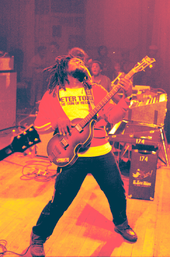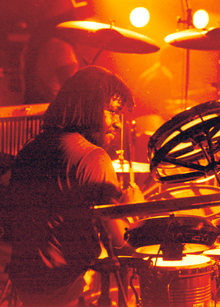A standard drum kit which is generally used in reggae, but the snare drum is often tuned very high to give it a timbales-type sound. Some reggae drummers use an additional timbale or high-tuned snare to get this sound. Cross stick technique on the snare drum is commonly used, and tom-tom drums are often incorporated into the drumbeat itself.
 Reggae drumbeats fall into three main categories: One drop, Rockers and Steppers. With the One drop, the emphasis is entirely on the third beat of the bar (usually on the snare, or as a rim shot combined with bass drum). Beat one is completely empty, which is unusual in popular music. There is some controversy about whether reggae should be counted so that this beat falls on three, or whether it should be counted half as fast, so it falls on two and four. Leroy "Horsemouth" Wallace calls the beat the "two-four combination".[citation needed] Many credit Carlton Barrett of The Wailers as the creator of this style.[citation needed] An example played by Barrett can be heard in the Bob Marley and the Wailers song "One Drop". Barrett often used an unusual triplet cross-rhythm on the hi-hat, which can be heard on many recordings by Bob Marley and the Wailers, such as "Running Away" on the Kaya album.
Reggae drumbeats fall into three main categories: One drop, Rockers and Steppers. With the One drop, the emphasis is entirely on the third beat of the bar (usually on the snare, or as a rim shot combined with bass drum). Beat one is completely empty, which is unusual in popular music. There is some controversy about whether reggae should be counted so that this beat falls on three, or whether it should be counted half as fast, so it falls on two and four. Leroy "Horsemouth" Wallace calls the beat the "two-four combination".[citation needed] Many credit Carlton Barrett of The Wailers as the creator of this style.[citation needed] An example played by Barrett can be heard in the Bob Marley and the Wailers song "One Drop". Barrett often used an unusual triplet cross-rhythm on the hi-hat, which can be heard on many recordings by Bob Marley and the Wailers, such as "Running Away" on the Kaya album.An emphasis on beat three is in all reggae drumbeats, but with the Rockers beat, the emphasis is also on beat one (usually on bass drum). This beat was pioneered by Sly and Robbie, who later helped create the "Rub-a-Dub" sound that greatly influenced dancehall. The prototypical example of the style is found in Sly Dunbar's drumming on "Right Time" by the Mighty Diamonds. The Rockers beat is not always straightforward, and various syncopations are often included. An example of this is the Black Uhuru song "Sponji Reggae."
 In Steppers, the bass drum plays four solid beats to the bar, giving the beat an insistent drive. An example is "Exodus" by Bob Marley and the Wailers. Another common name for the Steppers beat is the "four on the floor." Burning Spear's 1975 song "Red, Gold, and Green" (with Leroy Wallace on drums) is one of the earliest examples. The Steppers beat was adopted (at a much higher tempo) by some 2 Tone ska revival bands of the late 1970s and early 1980s.
In Steppers, the bass drum plays four solid beats to the bar, giving the beat an insistent drive. An example is "Exodus" by Bob Marley and the Wailers. Another common name for the Steppers beat is the "four on the floor." Burning Spear's 1975 song "Red, Gold, and Green" (with Leroy Wallace on drums) is one of the earliest examples. The Steppers beat was adopted (at a much higher tempo) by some 2 Tone ska revival bands of the late 1970s and early 1980s.An unusual characteristic of reggae drumming is that the drum fills often do not end with a climactic cymbal. A wide range of other percussion instrumentation is used in reggae. Bongos are often used to play free, improvised patterns, with heavy use of African-style cross-rhythms. Cowbells, claves and shakers tend to have more defined roles and a set pattern
Tiada ulasan:
Catat Ulasan